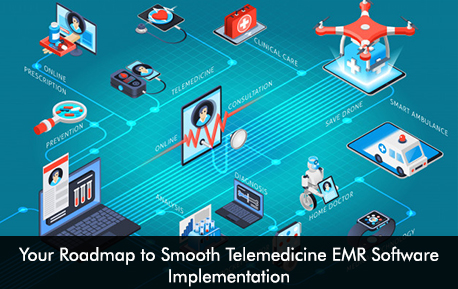The Covid-19 pandemic accelerated Telemedicine EMR Software adaptation rates in hospitals and clinics. Independent practices and hospitals started to purchase and deploy telemedicine solutions to offer remote care opportunities to their patients for effective diagnosis and treatment. Telemedicine for physical consultations was the highest in the USA as compared to Europe and Asia according to the latest global Sermo Survey. As practices in the US embrace telemedicine tools and platforms they are bound to make some errors in the implementation as it is still a new provision. To avoid these mistakes we have prepared a roadmap for the best practices for telemedicine software execution, for smooth implementation that can result in a better return on investment shortly.
Best Practices for Telemedicine Program Implementation
- Training staff members with the new software technology – To make the most out of your telemedicine EMR software system it is critical that practices take training seriously. Many healthcare professionals and staff members don’t have any prior experience of using telemedicine tools and hence training becomes important so your whole team is comfortable and confident in using the software system. Telemedicine software vendors offer training services and materials to their users. The training sessions can also be recorded so that employees can refer to them if they have any issues. Training can help to introduce the staff to the new tools and features of the software and answer any questions physicians and staff members have regarding operating the software.
- Take your patients on board – If your patients aren’t aware of the healthcare services provided through the telemedicine platform then your practice will be at a loss. After training you need to market your new telemedicine services to your patients this can be done by sending a mass email or a text message. The marketing of the software platform should inform that patient about the benefits of telemedicine and helpful resources on how they can schedule their virtual session with their respective provider.
- Focus on privacy – Before purchasing your telemedicine software platform make sure that the vendor offers HIPAA compliance to ensure that the software solution is encrypted and provides security and patient privacy. The vendor should offer strong encryption and regular software updates and backups for patient data. The Telemedicine EMR Software system should have key security functionalities including automatic log-off and remotely deleting data.
- Easy to use technology – Always give focus to an intuitive user interface that is user-friendly and easy to navigate. The innovative technology of telemedicine should allow practitioners to manage their telemedicine appointments and sessions easily from anywhere using a smartphone app.
Wrapping it up
By ensuring a smooth implementation of telemedicine software practices can offer high-quality patient monitoring and diagnosis using telecommunication tools. When staff members and doctors are confident in using the software solution they can provide the best remote healthcare services to their patients and overcome that many challenges with a thorough implementation strategy and the roadmap we have shared. The daunting task is made simple to make sure the telemedicine program can be embraced rapidly to enhance patient outcome levels.
Final Tip
Once your practice has started with telemedicine don’t forget to take continuous feedback from your patients and staff members. This feedback is important to measure the success of the implementation program and can address any issues on time to further improve remote care services for your patients and keep them satisfied throughout their virtual treatment path.







